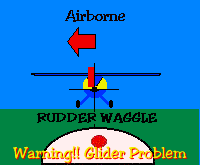In recent years, Premature Terminations of the Tow (PT3) have been a leading cause of glider accidents and pilot fatalities, second only to stall / spin related events. In spite of accident prevention efforts devoted to preventing this type of occurrence, the accident rate for launches of all types, aero-tow, ground, and self-launch remains exceptionally high.
Over the years, the term rope-break seems to have become synonymous of the wide range of occurrences that contribute to PT3 accidents. However, broken towlines are not the most common causal factor in PT3 accidents. In fact, a PT3 will more commonly occur as a result of some other event – an event that involves a significant level of distraction for the pilot. The most common factors that contribute to PT3 accidents include inadvertent extension of the spoilers / dive brakes during takeoff or climb, and improperly closed or locked canopy, mechanical related occurrences, and the failure of the pilot to maintain a proper tow position.
The most troubling aspect of PT3 related accidents is that many of these events are preventable through the application of basic accident prevention procedures. The Soaring Safety Foundation strongly encourages all pilots to adopt the following accident prevention strategies to help prevent PT3 accidents.
Effective Use of Checklists
Checklists are designed to confirm that specific safety of flight items have been accomplished prior to a specific phase of flight. The SSF encourages all pilots to exercise proper checklist discipline and to use a checklist appropriate to the glider being flown. Pilots should ensure that all checklist items are completed in a timely manner and in the proper sequence regardless of the specific checklist being used.
Takeoff Emergency Planning
The most important strategy available for the prevention of PT3 accidents is the development on an emergency plan prior to every takeoff. The SSF stresses the importance of planning for abnormal occurrences during launch by encouraging the addition of the letter E, for Emergency Plan, to all pre-takeoff checklists.
Proper Use of SSA Recommended Signals
In 1993, the Soaring Safety Foundation adopted the use of a new visual signal to warn the glider pilot on tow that the glider’s dive brakes / spoilers may be inadvertently extended. Proper use of this signal can alert the glider pilot as to the improper configuration of the glider before a PT3 event occurs. The SSF strongly encourages every pilot to become familiar with the Standard American Soaring Signals and to use these signals properly.

Effective Use of Resources
Proper training of individuals involved with launch operations (tow-pilots, wing-runners, etc.) is an important aspect of the prevention of PT3 accidents. Wing-runners should be trained to confirm proper configuration of the glider (spoilers closed, canopy closed and locked) and to scan for conflicting traffic in the pattern prior to initiating the Begin Takeoff signal. Tow-pilots must also be cognizant of potential problems associated with configuration of the towing aircraft and the glider. Tow-pilots must also closely monitor takeoff performance to identify potential problems early in the launch sequence.
Remember, the best opportunity to prevent a PT3 accident is before the glider leaves the ground. Through proper checklist usage, development of pre-takeoff emergency planning, and proper use of accident prevention resources we can minimize the opportunity for PT3 accidents to occur and make the sport safer for everyone.



Leave A Comment
You must be logged in to post a comment.